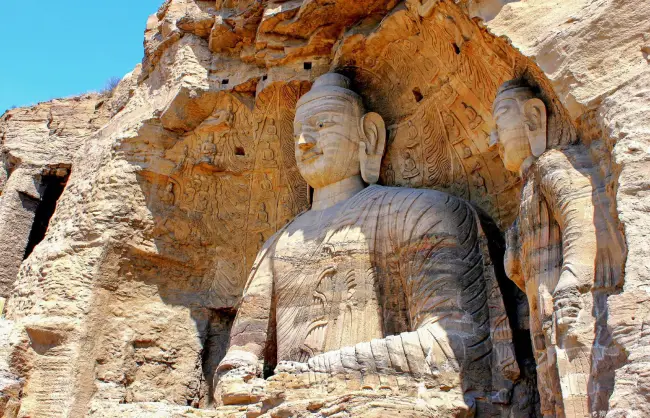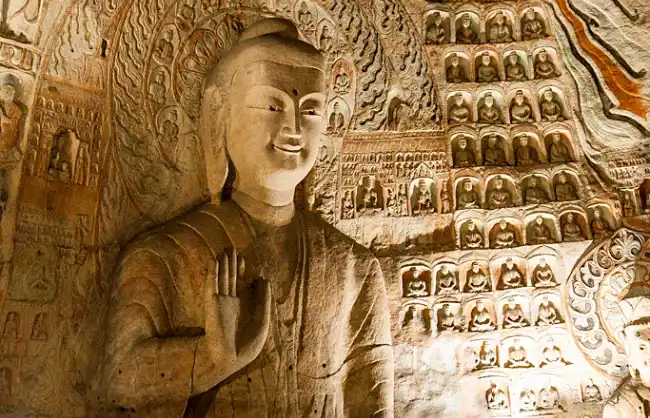Yungang Grottoes is 17km away from Datong City of Shanxi Province, so when travel to Datong, Yungang Grottoes is a must-visit site. It is globally recognized as the UNESCO World Heritage Site, and is renowned for its more than 51,000 Buddha statues and engravings dated back to 5th and 6th century AD.
This impressive site spans more than 1 kilometer with 252 caves and niches in it and the largest statue is up to nearly 17 meters high, which shows ancient Chinese sculptor’s outstanding craftsmanship. For tourists who are interested in Chinese Buddhist art and culture, Yungang Grottoes is a fantastic place to explore.
Yungang Grottoes Facts
- In Chinese: 云冈石窟
- Location: In Wuzhou Mountain, about 16 kilometers (10 miles) away the west of Datong City, Shanxi Province, China.
- Opening time:8:30 am to 5:00 pm (April to October); 8:30 am to 4:30 pm (November to March).
- Ticket price: CNY 150/person (April to October); 125 yuan/person (November to March).
- Time needed: 2 to 3 hours.
- Best visiting time: Spring and Autumn.
- Best for: History and culture lovers, Buddhist art lovers, and photographers.

History of Yungang Grottoes
Yungang Grottoes in Datong of Shanxi is proof of ancient Chinese sculptor’s craftsmanship and technique. This site was formed in the Northern Wei Dynasty (5th to 6th century) by the engravings on the rock cliff, during which Chinese Buddhism was influenced.
The construction of this site was originally started by Emperor Xiaowen, who thought it was a legal chance of spreading Buddhism.
The cultural meaning of Yungang Grottoes in Datong of Shanxi is that it is the bridge between Chinese and Buddhist culture, integrating traditional Chinese art and Buddhist iconology. This site also reflects the influence of Indian and Central Asian style, which was brought to China by the Silk Road.
The reappearance of Buddhist doctrines and stories in Yungang Grottoes helps the spread of Buddhism in China and makes it an important cultural and religious place. So for Datong tours, Yungang Grottoes is a good place to explore especially for the culture and Buddhist art lovers, etc.
What to See and Do in Yungang Grottoes
1. Amazed at the intricate sculptures:
During Datong tours, In the Yungang Grottoes of Datong, there are more than 51,000 Buddha statues and sculptures, and in each niche and cave, intricate sculptures are depicted in detail, showing ancient Chinese sculptors’ craftsmanship and technique. Tourists are amazed at the intricate details for several hours, and also impressed by the site scale.
2. Visit the largest Buddha statue:
The largest Buddha statue in Yungang Grottoes of Datong in Shanxi sits in the 5th cave with a height of 17 meters. This impressive statue is a must-visit scene and is regarded as a highlight of Yungang Grottoes.
3. Explore different caves and niches:
In Yungang Grottoes of Datong, there are a total of 252 caves and niches, and each has its unique engraving and story. Tourists can explore the different caves and niches and see the sculptures with different styles and themes.
4. Know the site’s history and culture:
Visiting the site museum is the best way to deeply know Yungang Grottoes’ history and cultural importance. The museum displays various cultural relics and exhibits, providing a background for site construction and its influence on China and Buddhist culture.
5. Appreciate the surrounding scenes:
Yungang Grottoes sits in a scenic area, which is surrounded by mountains and rivers. Tourists can walk or hike around the surroundings.

Best Time to Visit Yungang Grottoes
The best time to visit Yungang Grottoes is from April to October. At that time, the weather is warm and comfortable, and the scene is rich and colorful.
Datong is a continental monsoon grassland climate with distinct four seasons. In Spring and Autumn, the weather is moderate, the rainfall is small, and the sky is clear. It is the ideal time to appreciate Spring’s peach blossom and Autumn’s golden leaves. In Summer, it is cool and moist and rains off and on.
However, winter isn’t the recommended time because the weather is very cold, dry, and windy, and often snows. When the temperature decreases below 0℃ (32℉), the grottoes will be closed due to snow or ice.
How to Get to Yungang Grottoes
By Bus: You can take the No. 2 or 12 Bus from the center of Datong City to Yungang Grottoes. Based on the different distances, the ticket price is 1 yuan/person or 1.5 yuan/person. About 50 minutes are needed by Bus.
By Taxi: Also you can take a taxi to Yungang Grottoes. The taxi fee is about 30 yuan to 40 yuan, which depends on the traffic and route. About 30 minutes are needed by taxi.
By Private car: To get a more comfortable and convenient experience, you can book a private car service, which provides a licensed car driver and a comfortable car. They can pick you up from the hotel or any place in Datong, and then take you to Yungang Grottoes directly.
Nearby Attractions of Yungang Grottoes
- Hanging Temple: One Buddhist temple, built on a cliff about 75 meters high above the ground; integrates the elements of Buddhism, Daoism, and Confucianism; there are 40 halls and pavilions in it.
- Mount Hengshan: One of the five sacred mountains of Daoism, located about 60 kilometers (37 miles) away southeast of Yungang Grottoes.
- Yingxian Wooden Pagoda: The oldest and tallest wooden pagoda in China, built in 1056 during the Liao Dynasty. This impressive building is up to 67 meters high with nine stories, and each story has its unique shape and design.
- Nine-Dragon Screen Wall: China’s largest Dragon Wall, built in 1392 of the Ming Dynasty. It is 45.5 meters (149 feet) long and 8 meters (26 feet) high and depicts the picture of nine dragons playing with pearls in the clouds and waves.
- Huayan Temple: China’s largest and most well-preserved temple of the Liao and Jin Dynasty, located in Datong, divided into the Royal Ancestral Hall and the Buddhist Scripture Library. In the temple, many precious historical relics are collected, such as statues, paintings, scriptures, and steles.









